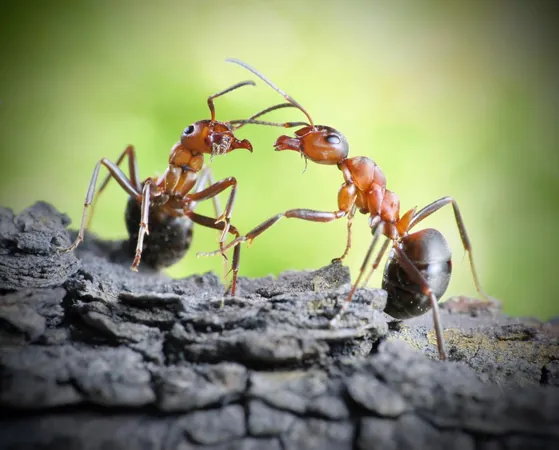
Unveiling the Genetic Secrets of Ants: How Evolution Forged Ultimate Teamwork
2025-07-05
Author: Siti
Ants are the true champions of teamwork, outnumbering humans by an astonishing 2.5 million to one, collectively weighing about 12 million tons of carbon. That’s equivalent to a fifth of the weight of all humanity on land!
A groundbreaking study involving an international team of researchers has delved into the genomes of 163 ant species, revealing how these social insects have evolved their incredible cooperative living skills over a span of more than 100 million years.
Unlocking the Genetic Code of Cooperation
Dr. Lukas Schrader from the University of Münster, who played a pivotal role in this research, expresses his awe at the project's magnitude. For centuries, scientists like Charles Darwin were baffled by the phenomenon of sterile worker ants, which seemed to defy the principle of natural selection. However, the advent of inclusive-fitness theory in 1964 illuminated this mystery by demonstrating that workers propagate their genes indirectly by supporting their sisters.
The new findings bolster this theory with genetic evidence, showing that worker-specific gene clusters across different ant lineages have remained nearly unchanged, suggesting that any harmful mutations affecting brood caretaking are swiftly eliminated.
Ant Colonies: Nature's Superorganisms
Biologists categorize ant colonies as superorganisms because their individual members operate like cells within a single entity. This extensive study, which includes both massive army ants and parasitic species devoid of workers, unearthed amazing genetic insights from 145 species across 25 countries.
Schrader describes the publication as a milestone, enhancing our understanding of the genetic and molecular foundations of ants and potentially other social insects, like honeybees.
Genes and Survival: A Delicate Balance
Researchers examined the genetic arrangement, discovering that certain gene blocks were restructuring themselves at a pace far more rapid than seen in vertebrates. Interestingly, 970 tiny gene clusters remained unchanged among 80% of the species surveyed, indicating their critical role in colony survival.
Some of these conserved gene clusters include vital functions that support metabolism and caste differentiation, essential for keeping the harmony of ant colonies intact.
Hormonal Control: Deciding the Fate of Ants
A single molecule can direct the fate of an ant larva, determining whether it will become a queen or a worker. This process relies heavily on juvenile hormone, with variations in gene copies noted in species displaying pronounced size differences between queens and workers.
In the study, genetic pathways involved in growth regulation also showed notable adaptations, illustrating how ants utilize hormonal signaling to fine-tune their roles within the colony.
A Window into Evolutionary Innovation
Evolutionarily, larger colonies have evolved alongside noticeable differences in queen-worker roles, both linked to vital survival behaviors. Genes associated with brain development showcase signs of adaptive change, especially in species with diverse worker types.
Remarkably, while social parasites have shed certain genes because of their streamlined roles, they exhibit drastic chromosomal changes, reflecting their niche in the ecosystem.
Lessons from Ants: Navigating Social Evolution
The exploration of ants' genetic landscape teaches us about the flexibility and conservatism of nature. Ants may have established their genetic code over 150 million years ago, serving as a living timeline for understanding social evolution.
Knowing how certain genes maintain their linkage during caste evolution could have significant implications in synthetic biology—potentially aiding in engineering specialized divisions of labor in microbes or even human tissues.
Through their petite forms, ants illuminate the intricate dance of cooperation that shapes ecosystems. Future investigations will reveal if this genetic orchestration recurs whenever personal interests give way to collective success.
This landmark study is featured in the journal Cell, offering a fascinating glimpse into the life of one of nature’s most extraordinary teams.

 Brasil (PT)
Brasil (PT)
 Canada (EN)
Canada (EN)
 Chile (ES)
Chile (ES)
 Česko (CS)
Česko (CS)
 대한민국 (KO)
대한민국 (KO)
 España (ES)
España (ES)
 France (FR)
France (FR)
 Hong Kong (EN)
Hong Kong (EN)
 Italia (IT)
Italia (IT)
 日本 (JA)
日本 (JA)
 Magyarország (HU)
Magyarország (HU)
 Norge (NO)
Norge (NO)
 Polska (PL)
Polska (PL)
 Schweiz (DE)
Schweiz (DE)
 Singapore (EN)
Singapore (EN)
 Sverige (SV)
Sverige (SV)
 Suomi (FI)
Suomi (FI)
 Türkiye (TR)
Türkiye (TR)
 الإمارات العربية المتحدة (AR)
الإمارات العربية المتحدة (AR)